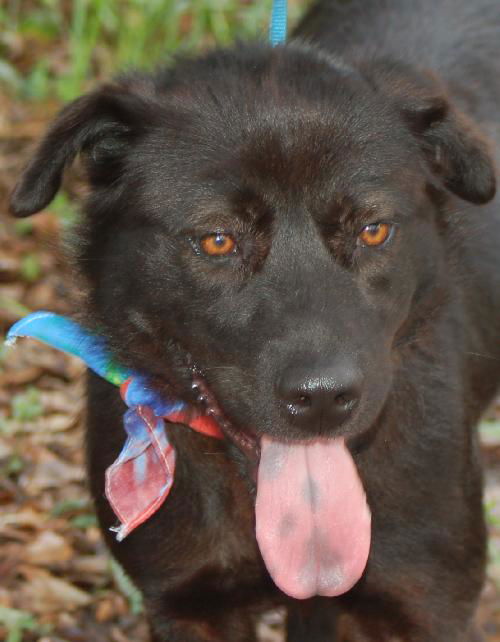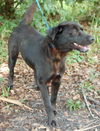
| My Rescue |
| Login to Remember your Favorite Animals and Breeds! |
Learn more about the Rottweiler.
Look at Maggie's eyes! Aren't they spectacular? They look like glistening chestnuts! Everything about Maggie is a bit unexpected. At first glance you think she is "just" a Black Lab. Then you notice how the sunlight picks up tones of amber in her coat. Then you notice the wide forehead. And then she sticks out her tongue and she has faint black markings on it. Oh Maggie, who was your papa??? I am guessing that she is part Rottweiler ~ her eyes, ears and forehead just remind me of one. The spots on her tongue? Oh, that doesn't really tell you a thing. So often people assume that means Chow, but there are actually over 30 breeds of dogs with black tongues. One thing I do know, though, is Maggie is a wonderful dog!
06/19 Foster Update:
As far as with people, and consistently. Maggie is a giant black puddle of kisses and licking and trying to crawl up into your lap. When she is disciplined, (meaning a harsh "no" or put outside for a few minutes and ignored) she does everything to get in good graces. Licking, tail wagging, please-forgive-me-and still-love me sort of thing.
We think Maggie has the potty training for the most part. However, the problem with this assessment is that I am home all day and take the dogs out to the yard frequently for play. She has never just been left to her own devices. What upsets her is say, too much commotion in the house with a bunch of dogs running to the window because the mailman is here, a fight over a toy, it's her turn at the water bowl, somebody walked too close to her and she was spooked.......etc. I would hope that she gets to be an only dog.
The Truth About Those Black Tongues from www.chowwelfare.com
Does the black spot on your Labrador's tongue mean he's really a Chow mix? That mixed breed puppy in the shelter with a partially black tongue -- is that a sure sign he's part Chow? The answer to both questions is: No! The Chow Chow's blue-black tongue is one of the breed's most well known physical characteristics. It's also the most misunderstood.
The Chow is one of the most ancient breeds and is the ancestor of many breeds of today. The orgin of the Chow's black tongue is a mystery; we don't know how or why he came to have it.
We do know that the Chow is not the only breed with a blue-black tongue. The Chinese Shar-Pei shares this trait as well. A few other animals have black tongues, too: the giraffe, polar bear, and several breeds of cattle including the Jersey. We also know that blue-black spots on tongues are very common in dogs - more than 30 pure breeds are known to have members with spotted tongues. Spots on tongues are simply deposits of extra pigment, like birthmarks and freckles on people. Dogs often have spots of dark pigment on their skin, too, hiding under their coats. These spots can be large or small, many or few.
If a Chow's tongue has a pink spot on it, does that mean it's not purebred? No. Chow puppies' tongues are pink at birth. They darken to blue-black by 8-10 weeks of age. Some tongues don't cover completely and they may have small spots or splashes of pink. Elderly Chows and Chows with the dilute coat colors of cinnamon and blue sometimes lose tongue pigment as they age and develop pink spots.
What if the dog looks like a Chow but has a completely pink or mostly pink tongue? Knowledgeable Chowists agree that such dogs are not purebred Chows and might not have any Chow parentage at all. The Chow is a member of the spitz family, a large group of breeds that includes the Samoyed, Siberian Husky, Malamute, Akita, Shiba Inu, Pomeranian, Norwegian Elkhound, Keeshond, etc. They all share basic physical characteristics: a similar body structure, over-the-back tail carriage, upright triangular ears, and a dense offstanding coat. A Chow-looking dog with a pink tongue is more likely to be a mix of one of the other spitz-type breeds.
Breeds known to have members with spotted tongues:
Airedale, Akita, Australian Cattle Dog, Australian Shepherd, Belgian Sheepdog, Belgian Tervuren, Belgian Malinois, Bichon Frise, Bouvier de Flandres, Bull Mastiff, Cairn Terrier, Chinese Shar-Pei, Collie, Cocker Spaniel, Dalmatian, Doberman Pinscher, English Setter, Eurasier, Fila Brasileiro, Flat-coated Retriever, German Shepherd, Golden Retriever, Gordon Setter, Great Pyrenees, Irish Setter, Kai Ken, Keeshond, Kerry Blue Terrier, Korean Jindo, Labrador Retriever, Mastiff, Mountain Cur, Newfoundland, Pomeranian, Pug, Rhodesian Ridgeback, Rottweiler, Shiba Inu, Siberian Husky,Soft-Coated Wheaten Terrier,Tibetan Mastiff
Other Pictures of Maggie the Lab (click to see larger version):
 68.7k |
 39.8k |
 53.8k |
Copyright © Pet Rescue by Judy





